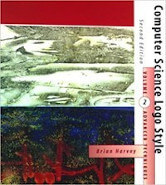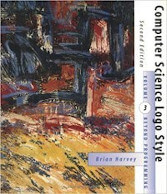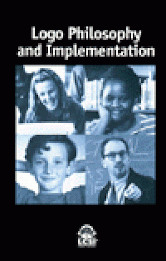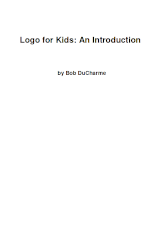Last Updated on April 18, 2024
4. Computer Science Logo Style Volume 2: Advanced Techniques by Brian Harvey
 This series is for people who are interested in computer programming because it’s fun. The three volumes use the Logo programming language as the vehicle for an exploration of computer science from the perspective of symbolic computation and artificial intelligence.
This series is for people who are interested in computer programming because it’s fun. The three volumes use the Logo programming language as the vehicle for an exploration of computer science from the perspective of symbolic computation and artificial intelligence.
Volume 2 includes a new tutorial chapter about macros, an exclusive capability of Berkeley Logo, and two new projects.
5. Computer Science Logo Style Volume 3: Beyond Programming by Brian Harvey
 This series is for people who are interested in computer programming because it’s fun. The three volumes use the Logo programming language as the vehicle for an exploration of computer science from the perspective of symbolic computation and artificial intelligence.
This series is for people who are interested in computer programming because it’s fun. The three volumes use the Logo programming language as the vehicle for an exploration of computer science from the perspective of symbolic computation and artificial intelligence.
The reader learns that computer science includes not just programming computers, but also more formal ways to think about computing, such as automata theory and discrete mathematics.
6. Logo Philosophy and Implementation by Seymour Papert, Clotilde Fonseca, Geraldine Kozberg and Michael Tempel, Sergei Soprunov and Elena Yakovleva, Horacio C. Reggini, Jeff Richardson, Maria Elizabeth B. Almeida, David Cavallo
 This is a book of stories each of which describes a large scale Logo implementation in a different country.
This is a book of stories each of which describes a large scale Logo implementation in a different country.
A good starting point is to ponder what the several projects described in the chapters have in common. What makes them all Logo projects?
Although the book is published by a company that has a commercial interest in Logo, it nevertheless reports as many examples of difficulties in the implementation of Logo as examples of uncomplicated successes.
Chapters examine:
- Introduction: What is Logo? And Who Needs It?
- The Computer in Costa Rica: A New Door to Educational and Social Opportunities.
- The Saint Paul Logo Project: An American Experience.
- The Russian School System and the Logo Approach: Two Methods Worlds Apart.
- A Logo Postcard from Argentina.
- Logo in Australia: A Vision of Their Own.
- The Constructionist Approach: The Integration of Computers in Brazilian Public Schools.
- Project Lighthouse in Thailand: Guiding Pathways to Powerful Learning.
7. Logo for Kids: An Introduction by Bob DuCharme
 This book is kind of like one of those Lego, Erector Set or K’nex kits. The book gives you pieces of the Logo programming language, just like those kits give you blocks or other building pieces, and it shows you how to put them together into several different projects.
This book is kind of like one of those Lego, Erector Set or K’nex kits. The book gives you pieces of the Logo programming language, just like those kits give you blocks or other building pieces, and it shows you how to put them together into several different projects.
After you’ve built those projects, you’ll have a better idea of what the different pieces can do.
Then the real fun starts: it’s time to make up your own creation.
Pages in this article:
Page 1 – LogoWorks: Challenging Programs in Logo and more books
Page 2 – Computer Science Logo Style Volume 2: Advanced Techniques and more books
All books in this series:
| Free Programming Books | |
|---|---|
| Ada | ALGOL-like programming language, extended from Pascal and other languages |
| Agda | Dependently typed functional language based on intuitionistic Type Theory |
| Arduino | Inexpensive, flexible, open source microcontroller platform |
| Assembly | As close to writing machine code without writing in pure hexadecimal |
| Awk | Versatile language designed for pattern scanning and processing language |
| Bash | Shell and command language; popular both as a shell and a scripting language |
| BASIC | Beginner’s All-purpose Symbolic Instruction Code |
| C | General-purpose, procedural, portable, high-level language |
| C++ | General-purpose, portable, free-form, multi-paradigm language |
| C# | Combines the power and flexibility of C++ with the simplicity of Visual Basic |
| Clojure | Dialect of the Lisp programming language |
| ClojureScript | Compiler for Clojure that targets JavaScript |
| COBOL | Common Business-Oriented Language |
| CoffeeScript | Transcompiles into JavaScript inspired by Ruby, Python and Haskell |
| Coq | Dependently typed language similar to Agda, Idris, F* and others |
| Crystal | General-purpose, concurrent, multi-paradigm, object-oriented language |
| CSS | CSS (Cascading Style Sheets) specifies a web page’s appearance |
| D | General-purpose systems programming language with a C-like syntax |
| Dart | Client-optimized language for fast apps on multiple platforms |
| Dylan | Multi-paradigm language supporting functional and object-oriented coding |
| ECMAScript | Best known as the language embedded in web browsers |
| Eiffel | Object-oriented language designed by Bertrand Meyer |
| Elixir | Relatively new functional language running on the Erlang virtual machine |
| Erlang | General-purpose, concurrent, declarative, functional language |
| F# | Uses functional, imperative, and object-oriented programming methods |
| Factor | Dynamic stack-based programming language |
| Forth | Imperative stack-based programming language |
| Fortran | The first high-level language, using the first compiler |
| Go | Compiled, statically typed programming language |
| Groovy | Powerful, optionally typed and dynamic language |
| Haskell | Standardized, general-purpose, polymorphically, statically typed language |
| HTML | HyperText Markup Language |
| Icon | Wide variety of features for processing and presenting symbolic data |
| J | Array programming language based primarily on APL |
| Java | General-purpose, concurrent, class-based, object-oriented, high-level language |
| JavaScript | Interpreted, prototype-based, scripting language |
| Julia | High-level, high-performance language for technical computing |
| Kotlin | More modern version of Java |
| LabVIEW | Designed to enable domain experts to build power systems quickly |
| LaTeX | Professional document preparation system and document markup language |
| Lisp | Unique features - excellent to study programming constructs |
| Logo | Dialect of Lisp that features interactivity, modularity, extensibility |
| Lua | Designed as an embeddable scripting language |
| Markdown | Plain text formatting syntax designed to be easy-to-read and easy-to-write |
| Objective-C | Object-oriented language that adds Smalltalk-style messaging to C |
| OCaml | The main implementation of the Caml language |
| Pascal | Imperative and procedural language designed in the late 1960s |
| Perl | High-level, general-purpose, interpreted, scripting, dynamic language |
| PHP | PHP has been at the helm of the web for many years |
| PostScript | Interpreted, stack-based and Turing complete language |
| Prolog | A general purpose, declarative, logic programming language |
| PureScript | Small strongly, statically typed language compiling to JavaScript |
| Python | General-purpose, structured, powerful language |
| QML | Hierarchical declarative language for user interface layout - JSON-like syntax |
| R | De facto standard among statisticians and data analysts |
| Racket | General-purpose, object-oriented, multi-paradigm, functional language |
| Raku | Member of the Perl family of programming languages |
| Ruby | General purpose, scripting, structured, flexible, fully object-oriented language |
| Rust | Ideal for systems, embedded, and other performance critical code |
| Scala | Modern, object-functional, multi-paradigm, Java-based language |
| Scheme | A general-purpose, functional language descended from Lisp and Algol |
| Scratch | Visual programming language designed for 8-16 year-old children |
| SQL | Access and manipulate data held in a relational database management system |
| Standard ML | General-purpose functional language characterized as "Lisp with types" |
| Swift | Powerful and intuitive general-purpose programming language |
| Tcl | Dynamic language based on concepts of Lisp, C, and Unix shells |
| TeX | Markup and programming language - create professional quality typeset text |
| TypeScript | Strict syntactical superset of JavaScript adding optional static typing |
| Vala | Object-oriented language, syntactically similar to C# |
| VHDL | Hardware description language used in electronic design automation |
| VimL | Powerful scripting language of the Vim editor |
| XML | Rules for defining semantic tags describing structure ad meaning |
